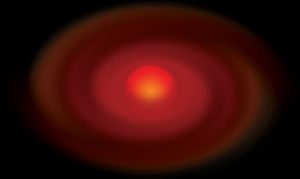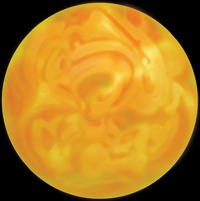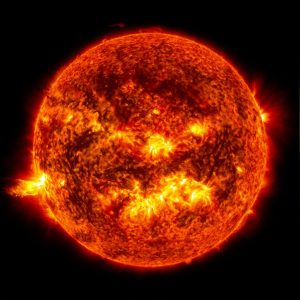GCSE Physics: Stars 1
This is the first of four blogs for GCSE Physics students.
It’s about the life cycle of stars.
We hope that our regular readers will enjoy it too.
Part 1 reveals how stars are born and why they shine.
In our next blog we’ll see how stars die.
You can find all the space science for GCSE Physics in our GCSE revision notes.

Starfield. Hubble Space Telescope, NASA/ES
Evidence
Star Colours
Over 100 years ago, astronomers calculated the surface temperatures of stars.
Temperatures ranged from over 30,000 degrees to 3,000 degrees.
And the temperatures gave stars their colours.

The hottest stars are blue.
Their temperatures are from 10,000 to 50,000 degrees C.

The next hottest are white stars with temperatures from 10,000 to 6,ooo degrees C.

Yellow stars have temperatures from 6,000 to 3,500 degrees.
Our Sun’s surface temperature is 5,800 degrees.

The least hot stars are red, with temperatures from 3,500 to 2,500 degrees C.
Hertzsprung & Russell
In 1913, two astronomers, used this temperature information.
They compared the temperature of stars with their brightness.
Their graph gave a big clue to the life cycle of stars.
It showed how stars changed as they grew older.
The graph is now called the H-R Diagram.
Let’s see how it works for us.
H-R diagram

Hertzsprung-Russell Diagram: Brightness v Temperature
On the graph, the vertical axis is brightness of stars, or luminosity.
The brightest stars are at the top, the dimmest at the bottom.
The brightness is true brightness. It is adjusted to cancel out the distance of each star.
The horizontal axis shows temperature.
Hottest blue stars to the left to least hot red stars at the right.
When we plot the positions of stars in the graph, they reveal their life cycle.
Most stars plot on the MAIN SEQUENCE.
The hottest blue stars are bright, the dim red stars are dim.
This is how we would expect normal stars to plot on the graph.
But some red stars appear at top right.
They are cool but bright.
These stars must therefore be very big – their light comes from a huge surface.
They are RED GIANT stars.
Some hot stars appear at the bottom left. They are hot but dim.
So they must be very small.
They are WHITE DWARF stars.
This was a huge clue to how stars live and die.
It is now known that Main Sequence stars are ‘normal’ stars.
They are fusing hydrogen to helium in theit cores.
The more massive ones are hot and bright, less massive are less hot and less bright.
Red giants are dying stars. They become swollen as their fuel is used up.
White dwarfs are dead stars.
They no longer produce energy.
Eventually they will simply fade to darkness.
The three kinds of stars are stars at different points in their life cycle.
So now we can tell the life story of stars.
Nebulae
All stars are created in huge clouds of gas and dust called nebulae.

The Orion Nebula. NASA/Hubble
An emission nebula like the Orion nebula glows red.
This colour comes from hydrogen gas, lit by the stars within it.
A nebula is made of around 90% hydrogen, the lightest element.
The rest is helium plus traces of nitrogen, oxygen, carbon and heavier elements.
Star Birth
The force that creates stars is gravity.
The fuel that makes stars shine is hydrogen.
As gas and dust swirls in the nebula, one part become denser than the rest.
The denser area has greater gravitational pull.
It draws in gas from around it.
The gravity increases and more gas is pulled in.
This part of the nebula begins to collapse and spin.
Protostar
The temperature rises as the gas is compressed.
After about a million years, it is a hot, glowing ball of gas.
It has become a protostar – not a star yet, but on its way.

Protostar. NASA / Chandra
A star is born
After several million years, the temperature at the centre of the protostar reaches ten million degrees or more.
This is a critical temperature and everything changes.
At 10 million degrees, hydrogen atoms fuse together to create helium.
The fusion reaction gives out enormous amounts of energy.
A star is born. it begins to shine, to radiate energy.

Sun type star. NASA/Chandra
Only the centre of the star, the core, reaches 10 million degrees.
This is the powerhouse of the star, its energy producer.
The gas outside the core, in the shell, does not reach 10 million degrees.
It cannot fuse but keeps collapsing inwards under its own gravity.

Forces inside a star. Dennis Ashton
The star achieves balance.
The radiation force from the core is balanced by the squeeze of gravity from the shell.
The ball of hydrogen is now a bright active star.
It is called a Main Sequence star.
The Sun is a typical main sequence star.

The Sun, a star. Photo: NASA
Star Lives
Stars will shine for millions, billions of years.
There is enough hydrogen in their cores to sustain their long life.
Sun-type stars
Stars similar to our Sun account for most of the stars visible in our night sky.
They will last for billions of years.
Our Sun’s life span is 10 billion years.
It is now around 5 billion years old so it has another 5 billion years of life remaining.

The Sun. Photo: NASA
Many Sun-type stars are bigger and brighter than the Sun.
Sirius, the ‘dog star’ is the brightest night-time star.
It is about twice the mass of the Sun and shines 25 times brighter.

Sirius in the winter sky. Image: Stellarium
When these common stars die, their death is dramatic but relatively gentle.
Blue Giant stars
The biggest stars weigh in at around 100 times the mass of the Sun.
They are massive, hot and blue: blue giant stars.
They are uncommon, making up only one percent of stars in the Milky Way.

Blue giant star. Credit: NASA
These superstars shine thousands of times brighter than our Sun.
The star Rigel in Orion is a blue giant.
It shines 50,000 times brighter than the Sun!

Rigel in Orion. Credit: Stellarium
The biggest stars have the shortest lives.
They burn up their hydrogen very fast.
They only last a few million years, a thousand times less than the Sun.
And when these stars die, they go in dramatic fashion.
They explode!
Coming next
In this blog we have begun the life cycle of stars.
We have seen how stars are created by gravity in huge clouds of gas.
They shine because of nuclear fusion reactions in their cores.
But within every star there is contest between radiation and gravity.
Next time we’ll see what happens when stars run out of fuel.
The battle between radiation and gravity reaches its climax.
We’ll discover how stars die.

The author: Dennis Ashton is a Fellow of the Royal Astronomical Society and a Wonderdome presenter.
Would you like to hear more Astronomy news?
Do you want to to find out about our upcoming public events?
Follow WonderDome Portable Planetarium on Twitter and Facebook or go to our web site wonderdome.co.uk

